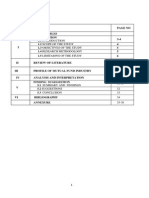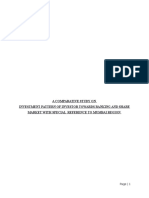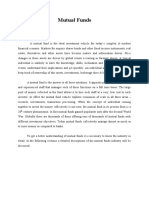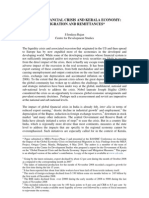Chapter 1 Introduction
Uploaded by
Malu PrasannaChapter 1 Introduction
Uploaded by
Malu PrasannaChapter-I
INTRODUCTION
~1~
Introduction to mutual funds
A Mutual Fund is a trust that pools the savings of a number of investors who share a common financial goal. The money thus collected is invested by the fund manager in different types of securities depending upon the objective of the scheme. These could range from shares to debentures to money market instruments. The income earned through these investments and the capital appreciation realized by the scheme is shared by its unit holders in proportion to the number of units owned by them (pro rata). Thus a Mutual Fund is the most suitable investment for the common man as it offers an opportunity to invest in a diversified, professionally managed portfolio at a relatively low cost. Anybody with an investible surplus of as little as a few thousand rupees can invest Mutual Funds. A mutual fund is the ideal investment vehicle for todays complex and modern financial scenario. Markets for equity shares, bonds and other fixed income instruments, real estate, derivatives and other assets have become mature and information driven. Price changes in these assets are driven by global events occurring in faraway places. A typical individual is unlikely to have the knowledge, skills, inclination and time to keep track of events, understand their implications and act speedily. An individual also finds it difficult to keep track of ownership of his assets, investments, brokerage dues and bank transactions etc.
~2~
A mutual fund is the answer to all these situations. It appoints professionally qualified and experienced staff that manages each of these functions on a full time basis. The large pool of money collected in the fund allows it to hire such staff at a very low cost to each investor. In effect, the mutual fund vehicle exploits economies of scale in all three areas research, investments and transaction processing. While the concept of individuals coming together to invest money collectively is not new, the mutual fund in its present form is a 20th century phenomenon. In fact, mutual funds gained popularity only after the Second World War. Globally, there are thousands of firms offering tens of thousands of mutual funds with different investment objectives.
NEED FOR THE STUDY
~3~
The main purpose of doing this project was to know about mutual fund and its functioning. This helps to know in details about mutual fund industry right from its inception stage, growth and future prospects.
Mutual funds have emerged as strong financial intermediaries and playing a very important role in bringing stability to the financial system and efficiency to resource allocation. Mutual funds have opened new vistas to investors and imparted a much-needed liquidity to the system. In the process they have challenged the hitherto role of commercial banks in the financial market and national economy.
Mutual funds in promoting economic development can be seen not only in terms of their participation in the savings market but also in their dominant presence in the money and capital market. A developed financial market is critical to overall economic development, and mutual funds play an active role in promoting a healthy capital market. The project study was done to ascertain the asset allocation, entry load, exit load, associated with the mutual funds. Ultimately this would help in understanding the benefits of mutual fund.
SCOPE OF THE STUDY
~4~
Scope of mutual fund has grown enormously over the years. In the first age of mutual funds. When the investment management companies started to after mutual funds, choices were few.
Even though people invested their money in mutual funds as these funds offered them diversified option for the first time.
By investing in these funds there were able to diversify their financial securities. At the same time they also enjoyed the advantage of liquidity with mutual funds, they got the scope of easy access to their invested funds on requirement. The study also helped me to put the learning into practice and to get a feel of the market by interacting with the prospective investor. In my project the scope is limited to some prominent mutual funds in the mutual fund industry. I analyzed the funds depending on their schemes like equity, income, balance. But there is so many other schemes in mutual fund industry like specialized (banking, infrastructure, pharmacy) funds.
My study is mainly concentrated on equity schemes, the returns, in income schemes.
OBJECTIVES OF THE STUDY
~5~
To give a brief idea about the benefits available from Mutual Fund investment.
To give an idea of the types of schemes available. To discuss about the market trends of Mutual Fund investment. To study some of the mutual fund schemes and analyze them. Observe the fund management process of mutual funds. Explore the recent developments in the mutual funds in India. To give an idea about the regulations of mutual funds. To make investment in mutual funds by selecting the mutual funds that suits to the investor after through market research.
~6~
METHODOLOGY OF THE STUDY
Data Collection
To achieve the objective of the studying the mutual fund data has been collected. Research methodology carried for this study can be two types. 1) Primary Data 2) Secondary Data
Primary
Data
The data, which has being collected for the first time and it is the original data. In this project the primary data has been taken from BSL staff and guide of the project. Questionnaire: Primary data was collected by preparing questionnaire for customers. The questionnaire was filled through investors of Birla Sun Life Mutual Fund.
Secondary Data The secondary information is mostly taken from Fact Sheets of the Mutual
Funds, Books News papers& web sites.
Data
Tools and Analysis
The main Statistical tool used for the collection and analyses of data in this project are: Questionnaire Pai Charts Bar Diagrams
~7~
LIMITATIONS OF THE STUDY The time constraint was one of the major problems. The study is limited to the different schemes available under the mutual funds selected.
The study is limited to selected mutual fund schemes. The lack of information sources for the analysis part. Study is to the availability of Secondary data. Analysis of only tax aspects is explained. Since there was a time limitation for carrying out analysis of various other schemes.
Suggestions are only suggestive in nature.
Sampling Procedure: Universe:
The universe of the present study consists of all salaried employees (both public and private sector) and business people.The universe here is finite.
Sample Size:
From the universe, a sample of 50 people was drawn on a random basis. The sample consists of 25 employees from both public and private sector, 25 business people. They were in the age group of 25-55 years with experience ranging from 2-25 years.
Sampling Method:
Simple random sampling method was used by the researcher. The sample was collected on a simple random basis.
~8~
CHAPTARISATION
The project has been divided into the following chapters.
Chapter 1:- This chapter deals with Introduction, Need for the study, Scope of the study, and Objective of the study, Methodology of the study and Limitation of the study.
Chapter 2:- This chapter deals with Advantages of mutual fund, Mutual Funds for whom?, History and Concept, Calculation of NAV, Global Scenario, History of Indian Mutual Fund Industry, Types of Mutual Funds.
Chapter 3:- This chapter deals with Industrial Profile, Company Profile and Introduction about Birla Sun Life Mutual Funds.
Chapter 4:- This Chapter deals with Data Analyses and Presentation.
Chapter 5:- This chapter deals with Findings, Suggestions, Conclusions and Questionnaire.
~9~
You might also like
- A Comparative Study On Banking Sector Mutual Funds - NetworthNo ratings yetA Comparative Study On Banking Sector Mutual Funds - Networth10 pages
- Chapter 11 An Introduction To Derivative Markets and Securities100% (1)Chapter 11 An Introduction To Derivative Markets and Securities29 pages
- A Study On Different Mutual Funds Providers in IndiaNo ratings yetA Study On Different Mutual Funds Providers in India121 pages
- B.K. School of Business Management Gujarat UniversityNo ratings yetB.K. School of Business Management Gujarat University77 pages
- Comparitive Analysis of Mutual Funds With Equity Shares Project Report78% (69)Comparitive Analysis of Mutual Funds With Equity Shares Project Report83 pages
- A Study On Factors Affecting Investment On Mutual Funds and Its Preference of Retail InvestorsNo ratings yetA Study On Factors Affecting Investment On Mutual Funds and Its Preference of Retail Investors4 pages
- Chapter - I: There Are A Lot of Investment Avenues Available Today in The Financial Market For An Investor WithNo ratings yetChapter - I: There Are A Lot of Investment Avenues Available Today in The Financial Market For An Investor With7 pages
- A Comparative Analysis of Public and Private Sector Mutual100% (1)A Comparative Analysis of Public and Private Sector Mutual17 pages
- A Study On Comparative Investment Analysis of Mutual Funds AT HDFC Bank LTDNo ratings yetA Study On Comparative Investment Analysis of Mutual Funds AT HDFC Bank LTD12 pages
- Review Literature - 01 (12 Files Merged)No ratings yetReview Literature - 01 (12 Files Merged)12 pages
- Financial and Investment Planning in Reference To Mutual Funds IndustryNo ratings yetFinancial and Investment Planning in Reference To Mutual Funds Industry16 pages
- A Comparative Study On Investment Pattern of Investor Towards Banking and Share Market With Special Reference To Mumbai RegionNo ratings yetA Comparative Study On Investment Pattern of Investor Towards Banking and Share Market With Special Reference To Mumbai Region41 pages
- An Study On Mutual Fund in India: BY S.Kathiresan 17BBA021No ratings yetAn Study On Mutual Fund in India: BY S.Kathiresan 17BBA02126 pages
- A Synopsis: Master of Business Administration 2011 - 2012No ratings yetA Synopsis: Master of Business Administration 2011 - 20128 pages
- Dissertation Report On Reliance Mutual Fund100% (2)Dissertation Report On Reliance Mutual Fund8 pages
- Chapter-1: Comperative Statement Analasis of Mutul FundsNo ratings yetChapter-1: Comperative Statement Analasis of Mutul Funds101 pages
- An Introduction to Stocks, Trading Markets and Corporate Behavior: Student EditionFrom EverandAn Introduction to Stocks, Trading Markets and Corporate Behavior: Student Edition3/5 (2)
- An easy approach to common investment funds: The introductory guide to mutual funds and the most effective investment strategies in the field of asset managementFrom EverandAn easy approach to common investment funds: The introductory guide to mutual funds and the most effective investment strategies in the field of asset managementNo ratings yet
- An Introduction to Stocks, Trading Markets and Corporate Behavior: The Investor's GuideFrom EverandAn Introduction to Stocks, Trading Markets and Corporate Behavior: The Investor's Guide5/5 (2)
- "The Investor's Handbook: Mastering Short-term and Long-term Investment Strategies"From Everand"The Investor's Handbook: Mastering Short-term and Long-term Investment Strategies"No ratings yet
- Arnold, Glen - The Great Investors - Lessons On Investing From Master Traders-FT Press - Financial Times - Prentice Hall (2011)100% (1)Arnold, Glen - The Great Investors - Lessons On Investing From Master Traders-FT Press - Financial Times - Prentice Hall (2011)417 pages
- Private Equity and Venture Capital: Atul KediaNo ratings yetPrivate Equity and Venture Capital: Atul Kedia11 pages
- A Report Sample For All Bbs Students Providing Insights On How To Prepare Bbs 4th Year Project ReportNo ratings yetA Report Sample For All Bbs Students Providing Insights On How To Prepare Bbs 4th Year Project Report43 pages
- Need of Portfolio and Portfolio ManagementNo ratings yetNeed of Portfolio and Portfolio Management5 pages
- Day Trade Pairs Using Intraday Spread BandsNo ratings yetDay Trade Pairs Using Intraday Spread Bands4 pages
- Chapter 9 International Financial MarketsNo ratings yetChapter 9 International Financial Markets29 pages
- Outsourced Chief Investment Officer (OCIO) - Details, Activities and BenefitsNo ratings yetOutsourced Chief Investment Officer (OCIO) - Details, Activities and Benefits4 pages
- EPF Corporate Governance Principles and Voting Guidelines 2022No ratings yetEPF Corporate Governance Principles and Voting Guidelines 202216 pages
- Paper LBO Model Example: How To Rip Through A Paper LBO in 5 Minutes - PRIVATE EQUITY INTERVIEWS: THE OFFICIAL GUIDENo ratings yetPaper LBO Model Example: How To Rip Through A Paper LBO in 5 Minutes - PRIVATE EQUITY INTERVIEWS: THE OFFICIAL GUIDE22 pages
- ARSA 2014 International Conference Proceeding - Volume INo ratings yetARSA 2014 International Conference Proceeding - Volume I306 pages
- Global Financial Crisis and Kerala EconomyNo ratings yetGlobal Financial Crisis and Kerala Economy16 pages
- Instant Download Manias, Panics, and Crashes: A History of Financial Crisis, 8th 8th Edition Robert Z. Aliber PDF All Chapter100% (2)Instant Download Manias, Panics, and Crashes: A History of Financial Crisis, 8th 8th Edition Robert Z. Aliber PDF All Chapter79 pages
- Cryptocurrencies in Modern Finance: A Literature Review: Abderahman Rejeb, Karim Rejeb, John G. KeoghNo ratings yetCryptocurrencies in Modern Finance: A Literature Review: Abderahman Rejeb, Karim Rejeb, John G. Keogh26 pages
- Announcement Effect of Cash Dividend Changes on Share Prices _SHORT VERSIONNo ratings yetAnnouncement Effect of Cash Dividend Changes on Share Prices _SHORT VERSION32 pages
- U.S. Equity Index Fund (TDAM) : As at June 30, 2021No ratings yetU.S. Equity Index Fund (TDAM) : As at June 30, 20211 page
- Bond Valuation: by Sarah M. Balisacan, CPANo ratings yetBond Valuation: by Sarah M. Balisacan, CPA13 pages
- A Comparative Study On Banking Sector Mutual Funds - NetworthA Comparative Study On Banking Sector Mutual Funds - Networth
- Chapter 11 An Introduction To Derivative Markets and SecuritiesChapter 11 An Introduction To Derivative Markets and Securities
- A Study On Different Mutual Funds Providers in IndiaA Study On Different Mutual Funds Providers in India
- B.K. School of Business Management Gujarat UniversityB.K. School of Business Management Gujarat University
- Comparitive Analysis of Mutual Funds With Equity Shares Project ReportComparitive Analysis of Mutual Funds With Equity Shares Project Report
- A Study On Factors Affecting Investment On Mutual Funds and Its Preference of Retail InvestorsA Study On Factors Affecting Investment On Mutual Funds and Its Preference of Retail Investors
- Chapter - I: There Are A Lot of Investment Avenues Available Today in The Financial Market For An Investor WithChapter - I: There Are A Lot of Investment Avenues Available Today in The Financial Market For An Investor With
- A Comparative Analysis of Public and Private Sector MutualA Comparative Analysis of Public and Private Sector Mutual
- A Study On Comparative Investment Analysis of Mutual Funds AT HDFC Bank LTDA Study On Comparative Investment Analysis of Mutual Funds AT HDFC Bank LTD
- Financial and Investment Planning in Reference To Mutual Funds IndustryFinancial and Investment Planning in Reference To Mutual Funds Industry
- A Comparative Study On Investment Pattern of Investor Towards Banking and Share Market With Special Reference To Mumbai RegionA Comparative Study On Investment Pattern of Investor Towards Banking and Share Market With Special Reference To Mumbai Region
- An Study On Mutual Fund in India: BY S.Kathiresan 17BBA021An Study On Mutual Fund in India: BY S.Kathiresan 17BBA021
- A Synopsis: Master of Business Administration 2011 - 2012A Synopsis: Master of Business Administration 2011 - 2012
- Chapter-1: Comperative Statement Analasis of Mutul FundsChapter-1: Comperative Statement Analasis of Mutul Funds
- An Introduction to Stocks, Trading Markets and Corporate Behavior: Student EditionFrom EverandAn Introduction to Stocks, Trading Markets and Corporate Behavior: Student Edition
- An easy approach to common investment funds: The introductory guide to mutual funds and the most effective investment strategies in the field of asset managementFrom EverandAn easy approach to common investment funds: The introductory guide to mutual funds and the most effective investment strategies in the field of asset management
- An Introduction to Stocks, Trading Markets and Corporate Behavior: The Investor's GuideFrom EverandAn Introduction to Stocks, Trading Markets and Corporate Behavior: The Investor's Guide
- "The Investor's Handbook: Mastering Short-term and Long-term Investment Strategies"From Everand"The Investor's Handbook: Mastering Short-term and Long-term Investment Strategies"
- Arnold, Glen - The Great Investors - Lessons On Investing From Master Traders-FT Press - Financial Times - Prentice Hall (2011)Arnold, Glen - The Great Investors - Lessons On Investing From Master Traders-FT Press - Financial Times - Prentice Hall (2011)
- A Report Sample For All Bbs Students Providing Insights On How To Prepare Bbs 4th Year Project ReportA Report Sample For All Bbs Students Providing Insights On How To Prepare Bbs 4th Year Project Report
- Outsourced Chief Investment Officer (OCIO) - Details, Activities and BenefitsOutsourced Chief Investment Officer (OCIO) - Details, Activities and Benefits
- EPF Corporate Governance Principles and Voting Guidelines 2022EPF Corporate Governance Principles and Voting Guidelines 2022
- Paper LBO Model Example: How To Rip Through A Paper LBO in 5 Minutes - PRIVATE EQUITY INTERVIEWS: THE OFFICIAL GUIDEPaper LBO Model Example: How To Rip Through A Paper LBO in 5 Minutes - PRIVATE EQUITY INTERVIEWS: THE OFFICIAL GUIDE
- ARSA 2014 International Conference Proceeding - Volume IARSA 2014 International Conference Proceeding - Volume I
- Instant Download Manias, Panics, and Crashes: A History of Financial Crisis, 8th 8th Edition Robert Z. Aliber PDF All ChapterInstant Download Manias, Panics, and Crashes: A History of Financial Crisis, 8th 8th Edition Robert Z. Aliber PDF All Chapter
- Cryptocurrencies in Modern Finance: A Literature Review: Abderahman Rejeb, Karim Rejeb, John G. KeoghCryptocurrencies in Modern Finance: A Literature Review: Abderahman Rejeb, Karim Rejeb, John G. Keogh
- Announcement Effect of Cash Dividend Changes on Share Prices _SHORT VERSIONAnnouncement Effect of Cash Dividend Changes on Share Prices _SHORT VERSION
- U.S. Equity Index Fund (TDAM) : As at June 30, 2021U.S. Equity Index Fund (TDAM) : As at June 30, 2021

























































































